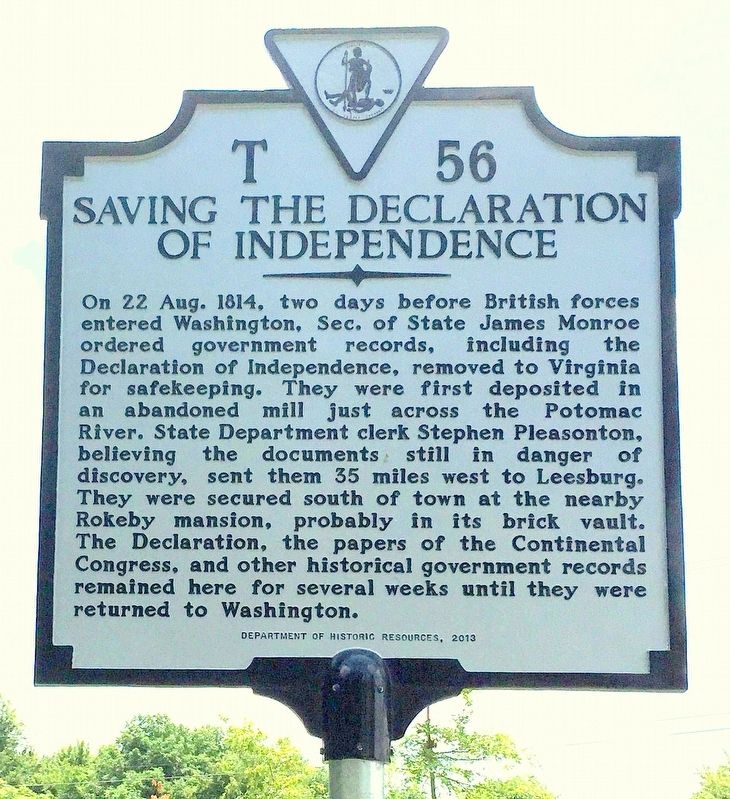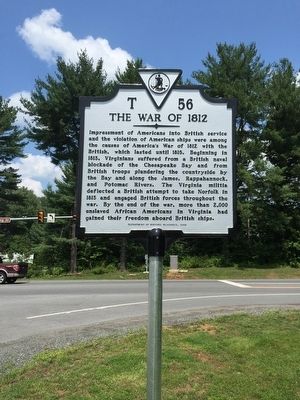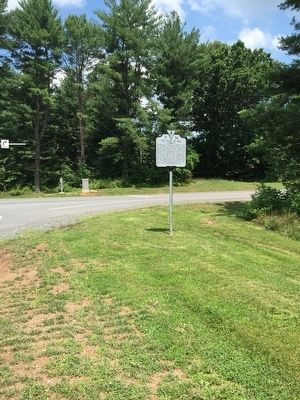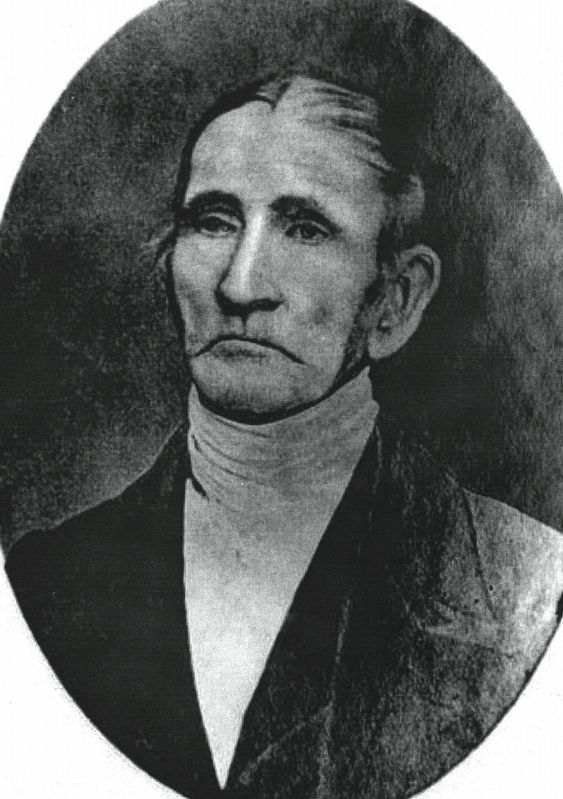Leesburg in Loudoun County, Virginia — The American South (Mid-Atlantic)
Saving the Declaration of Independence / The War of 1812
Saving the Declaration of Independence. On 22 Aug. 1814, two days before British forces entered Washington, Sec. of State James Monroe ordered government records, including the Declaration of Independence, removed to Virginia for safekeeping. They were first deposited in an abandoned mill just across the Potomac River. State Department clerk Stephen Pleasonton, believing the documents still in danger of discovery, sent them 35 miles west to Leesburg. They were secured south of town at the nearby Rokeby mansion, probably in its brick vault. The Declaration, the papers of the Continental Congress, and other historical government records remained here for several weeks until they were returned to Washington.
The War of 1812. Impressment of Americans into British service and the violation of American ships were among the causes of America's War of 1812 with the British, which lasted until 1815. Beginning in 1813, Virginians suffered from a British naval blockade of the Chesapeake Bay and from British troops plundering the countryside by the Bay and along the James, Rappahannock, and Potomac Rivers. The Virginia militia deflected a British attempt to take Norfolk in 1813 and engaged British forces throughout the war. By the end of the war, more than 2,000 enslaved African Americans in Virginia had gained their freedom aboard British ships.
Erected 2013 by Department of Historic Resources. (Marker Number T-56.)
Topics and series. This historical marker is listed in this topic list: War of 1812. In addition, it is included in the Former U.S. Presidents: #05 James Monroe, and the Virginia Department of Historic Resources (DHR) series lists. A significant historical date for this entry is August 22, 1814.
Location. 39° 5.191′ N, 77° 35.271′ W. Marker is in Leesburg, Virginia, in Loudoun County. Marker is at the intersection of South King Street (U.S. 15) and Masons Lane (County Route 654), on the right when traveling north on South King Street. Touch for map. Marker is in this post office area: Leesburg VA 20175, United States of America. Touch for directions.
Other nearby markers. At least 8 other markers are within 3 miles of this marker, measured as the crow flies. Royal Palm Turkey (approx. ¼ mile away); Rokeby (approx. one mile away); The Great Falls Line (approx. 1.8 miles away); Electric Trains on the W&OD (approx. 1.9 miles away); Leesburg Passenger Station (approx. 2.1 miles away); The W&OD Railway and Jim Crow Laws (approx. 2.1 miles away); This Is W&OD Trail: Leesburg! (approx. 2.1 miles away); Leesburg Freight Station (approx. 2.1 miles away). Touch for a list and map of all markers in Leesburg.
Also see . . . Wikipedia Entry for Stephen Pleasonton. “With the War of 1812 going poorly and worried that the British would attack Washington, Secretary of State James Monroe tasked Pleasonton with preserving the books and papers of the State Department. Pleasonton acquired several coarse linen bags, and filled them with all the Department's records. This included the still-unpublished secret journals of Congress, the commission and correspondence of George Washington, the Articles of Confederation, the United States Constitution, and all the treaties, laws, and correspondence of the Department made since 1789. He had all of this placed in coarse linen sacks and carted to a grist mill two miles beyond Georgetown.[4] Before he left, he noticed the Declaration of Independence had been forgotten and was still hanging in its frame on the wall, and took that as well. After one more day, Pleasonton became fearful that the British would destroy a nearby cannon foundry and possibly even the grist mill if they were to come to Washington, and procured wagons to take the material another thirty-five miles to Leesburg, Virginia, where they were stored in an empty stone house. That night, the British arrived and burned many buildings in the city. While the British left within two days, it was some weeks before the documents were returned to Washington.” (Submitted on July 1, 2016.)
Credits. This page was last revised on July 7, 2021. It was originally submitted on November 9, 2015, by Craig Swain of Leesburg, Virginia. This page has been viewed 2,104 times since then and 120 times this year. Photos: 1, 2, 3. submitted on November 9, 2015, by Craig Swain of Leesburg, Virginia. 4. submitted on July 1, 2016, by J. J. Prats of Powell, Ohio.



